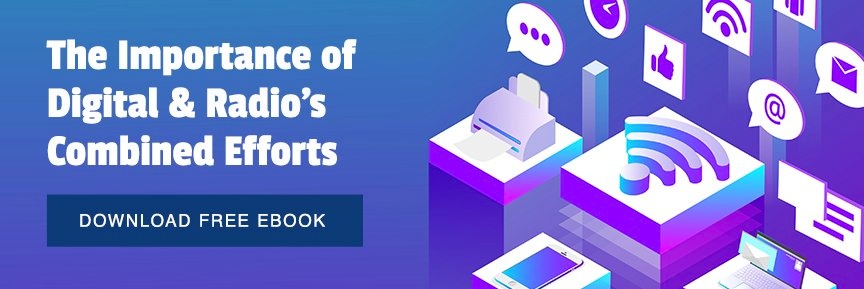Audio is booming, but not all audio is the same — especially when it comes to advertising. Today’s listeners have access to more content than with broadcast radio and digital streaming, and that amplifies opportunities for advertisers. In fact, radio ads boost your digital campaigns and vice versa.
With so many terms for each type of audio — local, AM/FM and over-the-air for traditional radio and streaming audio, digital streaming and streaming radio for digital platforms— it’s easy for advertisers to feel overwhelmed. Let’s sort out the differences between radio streaming and broadcast.
Reach and Accessibility
Broadcast radio follows a one-to-many model where stations transmit one feed for all listeners. Audience members tune in on the radio, often in their car and occasionally in their home if they listen on a traditional radio.
Radio streaming is similar in that listeners can tune into their favorite stations, but they use a digital device such as a smartphone, smart speaker like Amazon Echo, or even their computer. Digital technology allows users to take their favorite stations with them wherever they go, including on vacation.
Advertising Capabilities
Broadcast offers broad reach and scalability, raising brand awareness and purchase intent for massive audiences. It’s a powerful megaphone for your ads. Broadcast listeners typically hear the same ads in a geographic area and spots run in set time blocks.
On radio streaming, advertising can be targeted to listeners based on activities, demographics, and even location. This level of detail allows businesses to focus on particular audiences, improving conversion rates.
For example, Federated Media radio stations broadcast the same content on streaming as on-air, but the ads are dynamically placed digitally on the stream. If you listen to B100 on your car radio and on your smartphone at the same time, you’ll hear different ads (and someone listening on a smart speaker at the same time will hear a different ad at the same time too). This allows Federated Media advertisers to combine the power of digital targeting on the area’s most popular radio stations.
Community, Influencers and Connections
Local AM/FM radio stations are part of the fabric of their communities. DJs and hosts are popular influencers to endorse products and make community appearances. In addition, stations unite fans of music, news, and sports, building connections. In times of crisis, radio stations are a lifeline for critical information. That community-oriented nature creates loyal, engaged audiences.
Radio streaming builds communities of like-minded listeners — and these listeners are often the most passionate and loyal to their favorite station and hosts. Listeners who tune in through their phone or smart speaker typically listen for longer and consider themselves superfans. Though radio streaming attracts listeners from all over, many streamers are local to their favorite radio stations. It’s simply easier to listen through a smart device in today’s day and age when listening outside of the car.
Measurement Options
Advances in broadcast measurement are enabling more precise, targeted delivery. Local stations can segment audiences by demographics, activities, and location, while connecting in-store and online conversion to radio ad exposure. Emerging solutions, such as the attribution tool called Rumple that Federated Media uses to track spikes in advertisers’ website traffic after their commercials play, enhance radio reporting to help show ROI.
Radio streaming benefits from its digital nature, offering detailed reporting and analytics similar to online media. Advertisers can direct ads based on a user’s listening habits and preferences, segment audiences based on behaviors, and leverage ad tech to track campaigns in real-time, adjusting as necessary. Post-campaign analytics provide deeper insights to assess success and refine future strategies.
The Bottom Line:
Radio streaming and broadcast both offer advertisers access to engaged, passionate audiences. These listeners are responsive to ads and take action. You don’t have to choose between these two powerful options! By combining streaming and broadcast radio, businesses can amplify their message and optimize ad spending. Federated Media’s experienced marketing pros can create customized ad solutions that harness the power of both digital streaming and local radio, delivering optimal results.

